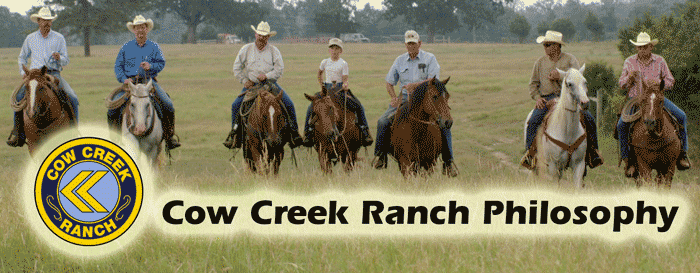At Cow Creek Ranch, Everything Comes from a Cow
The most significant component that sets the Cow Creek Ranch program apart from other seedstock suppliers is that we are self-sustaining. This strategy and reality forces the entire emphasis of our operation on production efficiency. We'll repeat. The entire emphasis of our operation is on production efficiency. This is not just significant, it's monumental. Maintaining an efficient, productive cow herd is the only option for successful, self-sustaining cattle producers. The result of that strategy, of which our customers are beneficiaries, is an efficient, effective, moderate framed, hard-footed cow herd with fleshing ability, volume, fertility and muscle mass. We have become masters of mobilizing our resources to drive our plan. We're accountable to our strategy. Our cows work for us. We don't work for them.
Every bull that goes through the Cow Creek system is a product of a disciplined genetic breeding system with selection pressure on production efficiency and profit. For nearly two decades, we have selected genetics that have the prepotency to reproduce a high percentage of sons and daughters that will be functional and profitable in our herd and do the same for our customers. We select for multiple, balanced traits. Unprofitable cattle are eliminated from the system. Period. No creep. No subsidies. This philosophy is the cornerstone of our breeding program.
After years of breeding Brangus and Angus and identifying genetic lines with production efficiency, we began stacking those genetics. Our goal was to create a self-sustaining breeding program with a homozygous gene base which produced progeny with little genetic variation. Our bull offering is a reliable source of genetics that will sire progeny with little genetic variation.
Stacking pedigrees is not a science and is only as effective as the integrity of selection pressure. As with any successful breeding program, truth and candor are required to allow genetics to be honestly expressed, i.e. no creep and no subsidies. Mama's milk and the calf's their potential. Our selection process focuses on the needs of the commercial producer, not on the show ring, not research from a university professor and not on trendy numbers. Our selection pressure is on quality, efficiency and consistency based on real world numbers.
"If all the gene pairs that control a trait are homozygous in a particular bull, the bull has no genetic variation for that trait, which means the bulls will pass identical genetics to each of his offspring. He will pass on traits with high reliability, known as prepotency. On the other hand, if a bull has a high number of heterozygous gene pairs, he has the potential to pass on many different genetic packages to his offspring. If a breeding program is to be successful at producing bulls with less genetic variation, practices should be used that will increase the percentage of homozygosity in those bulls," according to the Beef Improvement Federation.
Brangus and Ultrablacks¨ are composite breeds which, because of the two gene pools, compounds the heterozygosity factor from the two unrelated gene pools. Our emphasis of homozygosity to produce genetic consistency in a breeding program is even more paramount and intense because of the two gene pools. We are stacking pedigrees. We are not linebreeding. Linebreeding is system where all the animals used in a breeding program are from a singular line descent.
By utilizing our genetic breeding triangle we have tightly controlled and selected our genetic inputs and minimized the variation and gene pools in our cow herd, thereby increasing homozygous traits. We continue to genetic improvement through genetic selection pressure. Selection pressure the only way to achieve predictability in a breed with two gene pools while breeding homozygous traits. The Cow Creek cow herd is built around a genetic plan in which our goal is to produce as many high percentage cattle that breed and wean an efficient calf. If cattle do not reproduce efficiently, you have little chance of profit.
In the breed-characteristics taste test done by the Meat Animal Research Center (MARC), Clay Center, Nebraska, data showed that for trait after trait overall variation within most breeds is almost as wide as the total variation between breed averages. This data reinforces our contention there are huge differences in cattle within breeds. Less astonishing, the total variation indicates there is little consistency in American beef herds. The picture is crystal clear; there is profound difference in genetics programs.
